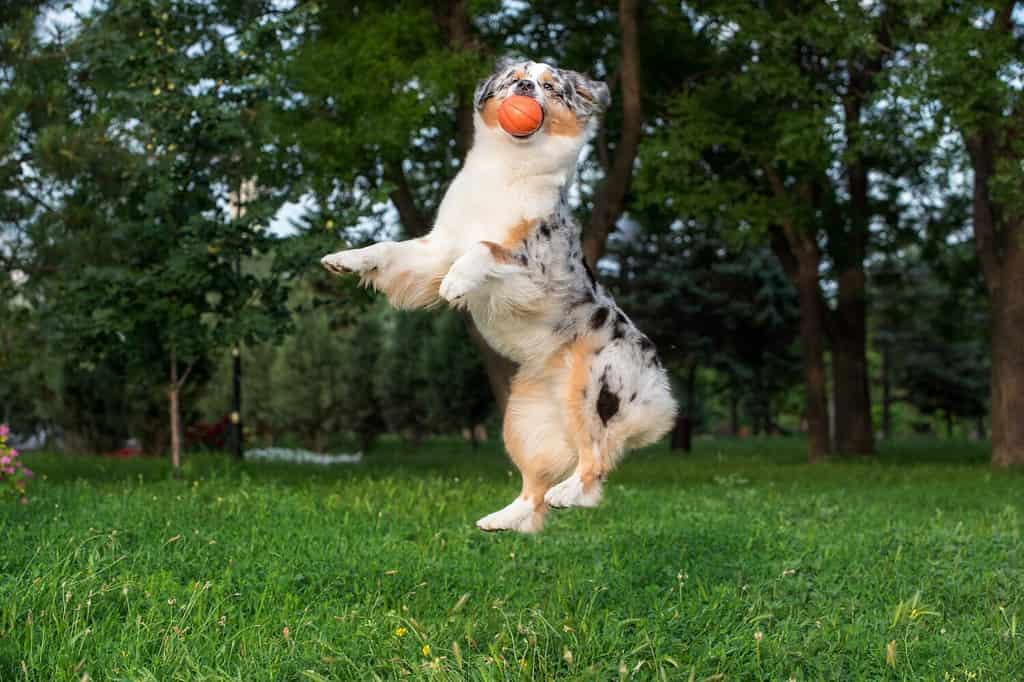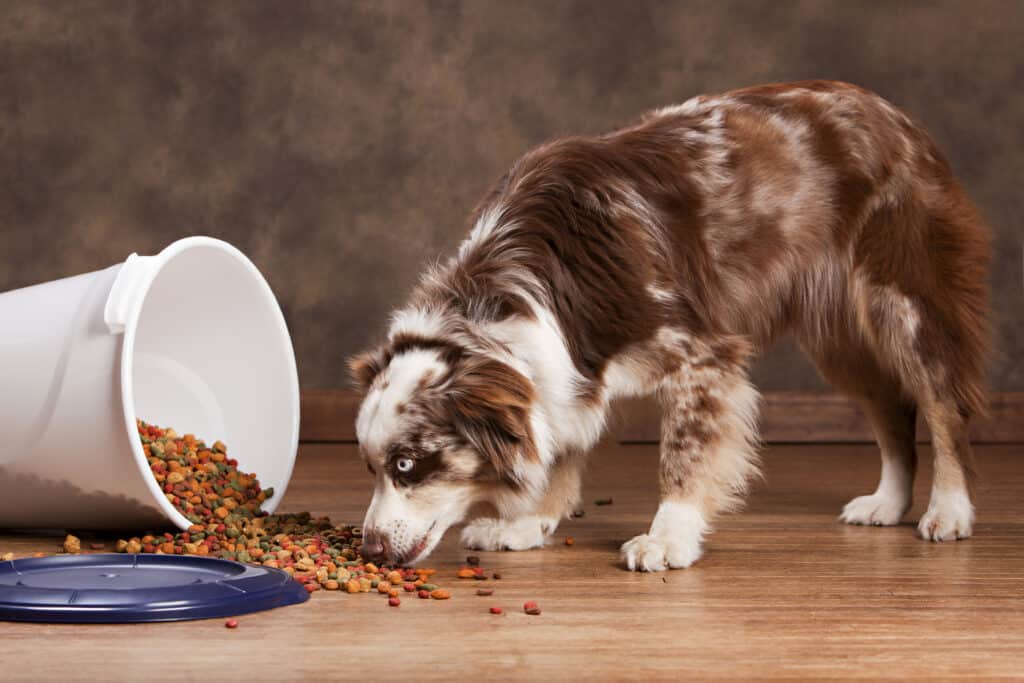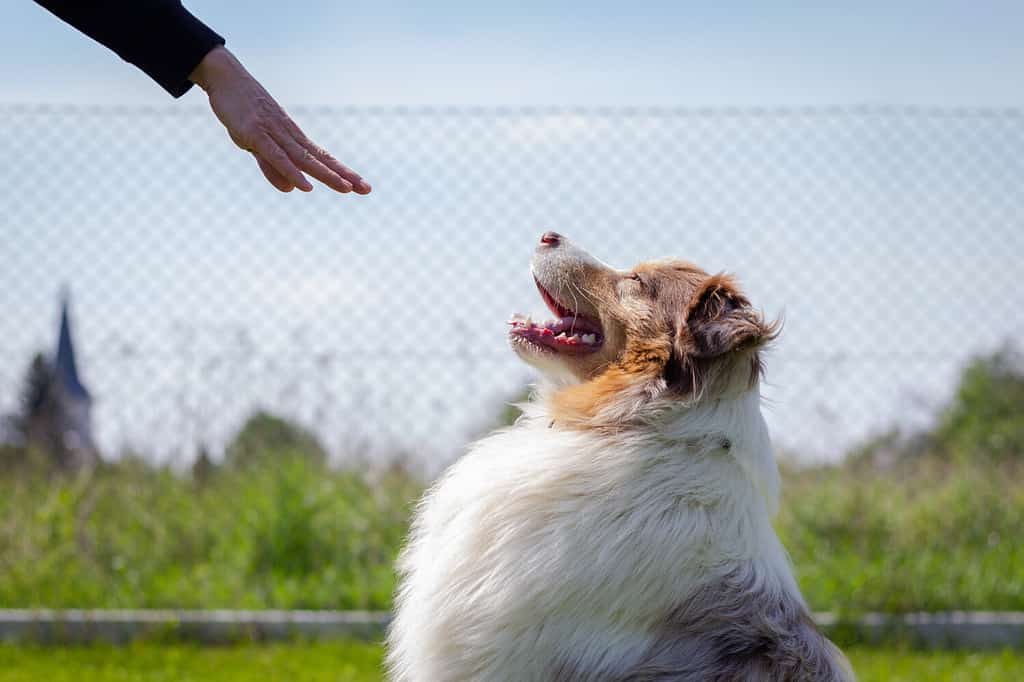Australian Shepherds were bred as working dogs for many decades. They’ve only recently begun appearing as solely companion animals. For this reason, many are exceptionally active. They’re often described as moving constantly and require tons of exercise.
For this reason, we can only recommend this breed for families that are very active. They do best when given a job, whether herding or a canine sport like agility. This breed is not a good companion animal for those who are gone for much of the day, as this often leaves little time to exercise them.
How Much Exercise Does an Australian Shepherd Need?
Australian Shepherds are working dogs, through and through. They were made to run around in the field all day, herding. Therefore, they’re very energetic and have a very high endurance level. They’re made to go.
If you keep them as companion animals, these canines need plenty of purposeful exercise. You cannot just put them in a backyard and expect them to get the proper amount of exercise. These dogs aren’t suitable for just hanging around the house.
Many dog owners acquire these dogs because they’re intelligent and very athletic. They look like fun dogs to own. However, many people sadly underestimate how much exercise and mental stimulation these dogs really need. You must provide them with hours of exercise each day, especially when they are younger.
If you want an easy-to-live-with dog that will greet you with a wagging tail each evening, this breed probably isn’t the best option for you. Some Aussies are pretty laidback, but those are the exception to the rule.
Why Should You Exercise Your Australian Shepherd

Games like fetch are a great way to help your Aussie exercise without tiring yourself out.
©ChocoPie/Shutterstock.com
When you properly exercise your Australian Shepherd, you’ll immediately see several benefits. They’ll be calmer overall, making them easier to train and handle. Australian Shepherds tend to be pretty hyperactive, so even calming them a little bit with exercise can be a huge benefit.
A well-exercised dog also tends to be a tired dog, and a tired dog probably isn’t going to get in trouble.
Aussies that are well-exercised also tend to be healthier. Their heart, muscles, joints, and lungs will stay healthier, just like they would in a human. This added health leads to a longer lifespan and lower vet bills.
Australian Shepherd Exercise Plan
Of course, saying, “This breed needs a lot of exercise,” is much different than telling you how to do the proper amount of exercise. Australian Shepherds need vigorous exercise. This means at least two 45-minute walks every day. These walks should be brisk, which means the dog should be trotting, not just inching along.
Plan on taking one walk in the morning and the other in the afternoon. For puppies, you may need to do several 15-minute walks instead. Puppies often tend to tire quickly, nap, and need more exercise. Shorter, more frequent exercise is recommended for younger dogs.
For all dogs, you should also provide extra exercise in the form of play and similar activities. Some dogs may need more “extras” than others, even at different times of their lives. However, you should still plan and offer it.
A fenced-in yard can be very helpful for this breed, but putting them in the yard and leaving them alone doesn’t count as “exercise.” Throwing a ball while they chase it does, though.
Never force an Australian Shepherd to exercise, especially when they are younger. You should plan for walks, but sometimes, the dog will tire before the walk is “scheduled” to be over. For puppies, forcing them to walk more can damage their hips, so we recommend several shorter walks throughout the day.
What Happens If You Don’t Exercise Your Australian Shepherd?

Aussies can be troublesome dogs when not properly exercised. Their intelligence can lead to them getting into all sorts of things!
©Michelle D. Milliman/Shutterstock.com
Australian Shepherds that aren’t properly exercised often exhibit problem behaviors. These dogs will become hyperactive, which can make them rambunctious. Aussies have a particular problem becoming overly energetic, which may make them harder to handle indoors when they’re younger.
Dogs aren’t made to wander around the house all day, especially a working breed like Australian Shepherds. Without exercise and daily walks, it doesn’t take a lot for the tireless dogs to become bored and destructive. They may decide to chew through your couch or zoom down a hallway continuously.
Barking and digging are also issues. The Aussie may look for anything to cure their boredom and pent-up energy, including barking at things that aren’t even there. Digging provides much-needed stimulation and may become particularly bad with unexercised Australian Shepherds.
It’s harder to control your dog’s behavior when their needs aren’t being met. Training may not help, especially if the dog is having difficulty paying attention due to hyperactivity. It’s important to provide training, but you also need to provide enough exercise.
A lack of exercise can also have health effects. Without proper exercise, your dog’s heart, lungs, and joints will be weakened. They’ll be prone to weight gain, diabetes, heart disease, joint disease, and digestive problems. A lack of exercise can take months or even years off of your dog’s lifespan.
Can You Exercise an Australian Shepherd in a Backyard?
Yes and no. You cannot simply put your dog in the backyard and expect them to get enough exercise. Dogs usually won’t run around a fenced-in yard by themselves for 45 minutes any more than humans do.
Most “exercising” done in a yard involves leisurely walking, sniffing, and rolling around – not nearly enough exercise for Australian Shepherds. Most dogs spend much of their outside time laying around and sleeping. Therefore, you shouldn’t count backyard time as “exercising.”
The only time that dogs can get exercised in a backyard is when you’re outside playing with them. Throwing a ball for your Australian Shepherd in a backyard absolutely counts. However, just letting a dog in the backyard doesn’t count.
Many owners purchase two dogs so that they will exercise each other. While two dogs can absolutely exercise each other, this isn’t a foolproof plan. The dogs may run around and play for a bit, but you can’t count on them to exercise each other. Dogs generally tend to exercise less as they get older, so you’ll still need to provide those daily walks.
You should never purchase another dog just because you hope it will help your dog exercise. Taking care of another dog is twice the work as taking care of one dog. Plus, dogs from the same litter can become prone to littermate syndrome, opening a new can of problems.
How Do You Tire Out an Australian Shepherd?

Training may also help an overactive Aussie, but all the training in the world won’t make up for a lack of exercise.
©encierro/Shutterstock.com
Many dog owners adopt an Australian Shepherd only to find that they are exceptionally hyperactive. They may be running at 100% all the time, especially before the age of two or three.
Not enough exercise can cause hyperactivity. Therefore, if your dog seems too active, we recommend more exercise. You should provide at least two 45-minute walks a day, which should be pretty vigorous, as well as extra playtime.
Some dogs may need even more than this, though. Here are some exercise ideas if your dog is still not tired after a couple of walks:
- Running or jogging
- Agility training
- Fetch
- Hiking
- Herding activities
- Swimming
- Bike Riding
- Tug of War
- Active games (like hide-and-seek)
- Interactive toys
- Frisbee
More exercise is often a great way to tire out an Australian Shepherd. However, at some point, you also have to accept that Australian Shepherds are just very energetic dogs. Some do not calm down until well into adulthood, no matter how much exercise they do.
For this reason, we don’t recommend adopting this breed unless you can deal with a very active dog.
Ready to discover the top 10 cutest dog breeds in the entire world?
How about the fastest dogs, the largest dogs and those that are -- quite frankly -- just the kindest dogs on the planet? Each day, AZ Animals sends out lists just like this to our thousands of email subscribers. And the best part? It's FREE. Join today by entering your email below.
Thank you for reading! Have some feedback for us? Contact the AZ Animals editorial team.








